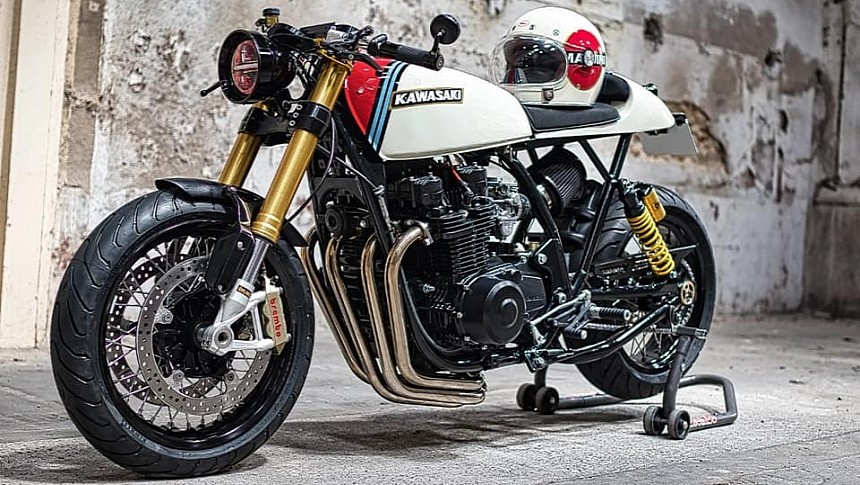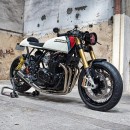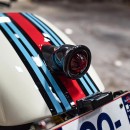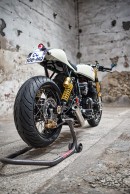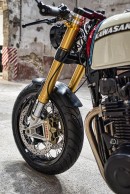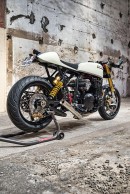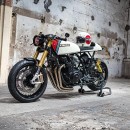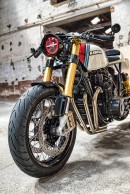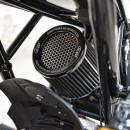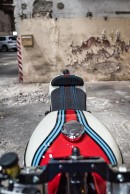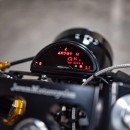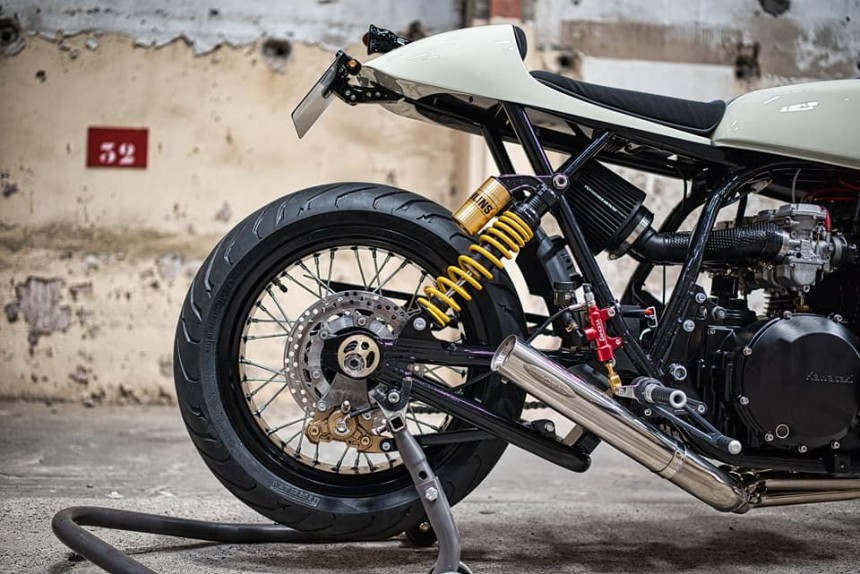As a successor to the legendary Kawasaki Z1 and Z900, the Z1000 (also known as KZ1000) really left its mark on the motorcycling world following its debut. It first hit the shelves for the model-year 1977, boasting a beefed-up engine capacity of 1,015cc thanks to an enlarged bore. The bigger inline-four mill could summon up to 83 hp at 8,000 rpm, and it exhaled via redesigned four-into-two pipework.
Now, what we’re actually here to talk about is a J variant from 1981, so it comes with a 998cc four-banger making just over 100 ponies. This is no regular Z1000 from Kawi’s range, though, as it had undergone an extensive custom makeover at Jerem Motorcycles of Beziers, France. Jeremie Duchampt is no stranger to building incredible one-offs, like the gorgeous BMW R 100 RT he’d nicknamed Nebula.
The said Beemer is an absolute head-turner, for sure, but we’re equally intrigued by what Jeremie managed to pull off on his Z1000 project! He didn’t give it a nickname this time around and that’s okay, because the bike has all the character it could ever ask for as it is. With these sorts of builds under his belt, Monsieur Duchampt must be a professional bike-modding guru with countless years of experience behind him, right?
Well, you may be surprised to learn this is not the case. The Frenchman had only completed his first fully-fledged bespoke project in 2019, and motorcycle customization isn’t his full-time occupation. Despite this, we can probably all agree that Jeremie’s a natural, with a great eye for detail and abilities to match those of renowned pros. Those things are apparent on his Kawasaki cafe racer, so let’s take a closer look at what’s going on here.
As the classic Japanese titan was being dismantled, its factory bodywork, suspension, and wheels have all been taken out of the equation. The original subframe got amputated, too, making room for a shorter handmade alternative fabricated in-house. Attached to it are premium Ohlins shock absorbers with progressive springs and piggyback reservoirs, while the repurposed swingarm of a Kawasaki ZRX1100 was installed lower down.
Peeking at the front end, we come across inverted forks and sturdy Brembo brakes, which had once belonged to a BMW R 1200 R. Laced 17-inch wheels occupy the footwear sector, and their rims are hugged by grippy Pirelli rubber. The rear tire measures a hefty 180 mm (7.1 inches) in width, so an offset front sprocket was also required to align the drive chain.
Jeremie upgraded the rear brake to match the front unit, thus bringing the Z1000’s handling into the 21st century. Four decades after it had come off the assembly line, the creature’s motor could really use a bit of TLC, as well. It was therefore rebuilt inside out, and the Mikuni carbs were ultrasonically cleaned before receiving some fresh breathing equipment.
This comes in the form of a custom one-into-four intake setup, which begins with a massive aftermarket air filter right beneath the seat. As for the Kawi’s exhaust, it is now a bespoke four-into-one affair terminating in a Delkevic muffler on the right. The French craftsman was looking for a slimmer profile when it came to the bodywork, so he placed a narrow fiberglass tail section atop the subframe.
Its rearmost portion is home to a Bates-style LED taillight, while a compact license plate bracket with integrated turn signals can be spotted underneath. The bike’s new solo seat was put together by a local upholstery specialist and regular Jerem Motorcycles collaborator. In front of it, one may find the slender fuel tank of a Kawasaki Z650, seamlessly complementing the lines and proportions of the rear bodywork.
Rounding out this Z1000’s outfit is a unique front fender that’s been built from scratch. Moreover, the red-tinted LED headlamp fitted higher up is yet another nice touch, and it’s held in place by way of bespoke mounting hardware. A CNC-machined top clamp takes center-stage in the cockpit, fronted by a tiny digital speedometer from Motogadget’s catalog. Clip-on handlebars also make an appearance, wearing inconspicuous switches and bar-end mirrors.
Aside from the instrumentation, Motogadget supplied a keyless ignition module and their tried-and-true mo.Unit controller for the electronics. The last thing for us to cover is the machine’s colorway – a job which Jeremie had once again decided to outsource to one of his trusted collaborators. A Martini-inspired livery found its way onto the fuel tank and tail, nicely complemented by the gold Ohlins suspension.
Black paint is the name of the game elsewhere, applied in a mixture of gloss and satin finishes. For continuity, the red and blue stripes are emulated by the stitching on the saddle – clear proof of Jeremie Duchampt’s remarkable attention to detail. If you ask me, it’s just a matter of time before this guy starts building custom motorcycles full-time, and it will be a very happy day for the bike-modding community when he does!
The said Beemer is an absolute head-turner, for sure, but we’re equally intrigued by what Jeremie managed to pull off on his Z1000 project! He didn’t give it a nickname this time around and that’s okay, because the bike has all the character it could ever ask for as it is. With these sorts of builds under his belt, Monsieur Duchampt must be a professional bike-modding guru with countless years of experience behind him, right?
Well, you may be surprised to learn this is not the case. The Frenchman had only completed his first fully-fledged bespoke project in 2019, and motorcycle customization isn’t his full-time occupation. Despite this, we can probably all agree that Jeremie’s a natural, with a great eye for detail and abilities to match those of renowned pros. Those things are apparent on his Kawasaki cafe racer, so let’s take a closer look at what’s going on here.
As the classic Japanese titan was being dismantled, its factory bodywork, suspension, and wheels have all been taken out of the equation. The original subframe got amputated, too, making room for a shorter handmade alternative fabricated in-house. Attached to it are premium Ohlins shock absorbers with progressive springs and piggyback reservoirs, while the repurposed swingarm of a Kawasaki ZRX1100 was installed lower down.
Jeremie upgraded the rear brake to match the front unit, thus bringing the Z1000’s handling into the 21st century. Four decades after it had come off the assembly line, the creature’s motor could really use a bit of TLC, as well. It was therefore rebuilt inside out, and the Mikuni carbs were ultrasonically cleaned before receiving some fresh breathing equipment.
This comes in the form of a custom one-into-four intake setup, which begins with a massive aftermarket air filter right beneath the seat. As for the Kawi’s exhaust, it is now a bespoke four-into-one affair terminating in a Delkevic muffler on the right. The French craftsman was looking for a slimmer profile when it came to the bodywork, so he placed a narrow fiberglass tail section atop the subframe.
Rounding out this Z1000’s outfit is a unique front fender that’s been built from scratch. Moreover, the red-tinted LED headlamp fitted higher up is yet another nice touch, and it’s held in place by way of bespoke mounting hardware. A CNC-machined top clamp takes center-stage in the cockpit, fronted by a tiny digital speedometer from Motogadget’s catalog. Clip-on handlebars also make an appearance, wearing inconspicuous switches and bar-end mirrors.
Aside from the instrumentation, Motogadget supplied a keyless ignition module and their tried-and-true mo.Unit controller for the electronics. The last thing for us to cover is the machine’s colorway – a job which Jeremie had once again decided to outsource to one of his trusted collaborators. A Martini-inspired livery found its way onto the fuel tank and tail, nicely complemented by the gold Ohlins suspension.
Black paint is the name of the game elsewhere, applied in a mixture of gloss and satin finishes. For continuity, the red and blue stripes are emulated by the stitching on the saddle – clear proof of Jeremie Duchampt’s remarkable attention to detail. If you ask me, it’s just a matter of time before this guy starts building custom motorcycles full-time, and it will be a very happy day for the bike-modding community when he does!
